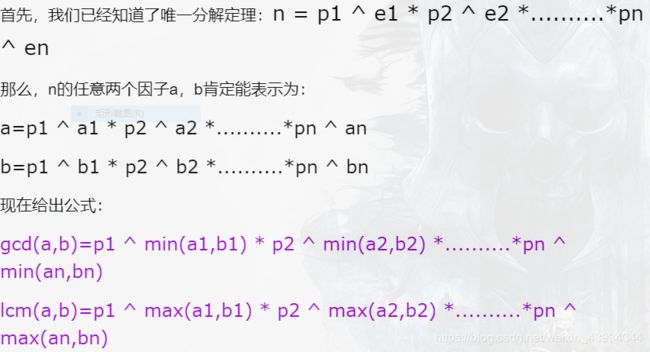西南科技大学第十六届ACM程序设计竞赛暨绵阳市邀请赛 补题报告
本补题报告仅供参考,顺序由简到难
C:给你一个数字n,你需要输出一个字符串,该字符串长度必须小于等于n,并且含有n个“AR”子序列。
贪心或者思维。
直接就想到每一个“A”后面有多少个“R”,那么就可以贡献多少个“AR”。所以,只需要凑出n个“AR”即可。
默认长度为n。
直接命令第一个字母为“A”,显然,后面如果全是“R”,只有n-1个“AR”,所以,只需要在倒数第三的位置填上一个“A”即可。
如此,第一个“A”贡献n-2个“AR”,倒数第三位置上的“A”贡献2个“AR”,凑成n个。
并且,通过思考,或者手画可以知道在n <= 3时是无法凑成n个“AR”的,输出-1.
#include B题:在1-n之间随机生成长度为n的整数序列,请问正好含有n-1个不同的整数的方案数,答案mod 1e9+7
长度为n,只含有n-1个不同的数字,所以必定有两个数字相同。
组合数学,从n个数字当中选出n-1个数字进行组合,为n。
其次,需要从n-1个数字当中选出哪个数字有两个,为n-1
之后将所有的数字进行排列组合,为n!
由于有两个数字相同,所以排列组合的结果需要 除2。
即ans = n*(n-1)* n! / 2 % 1e9+7
#include 值得注意的是,除法与取模的运算顺序,取模之后原本的偶数会变成奇数,进而再进行除法会影响结果,造成误差,导致WA。
E:给你n个数,求出最大的lcm。结果取余1e9+ 9.
求最大的lcm,那肯定是所有n个数的lcm最大。
自然想到了利用gcd来求lcm,多次除法与取余会导致误差WA,想到使用逆元也WA了(不理解)。
转而使用唯一分解定理:一个整数,一定可以唯一的分解为质因数相乘的形式。
针对n个数中的每一个数,我们都进行质因数分解,lcm,所以我们只保留每个质因数的最高幂次。

分解完之后,对所有的质因数进行快速幂取模,相乘取模即可。
#include 写完之后一直T,后来发现是唯一分解定理写垮了,还可以进行优化。
即原本的唯一分解定理是
for(int i = 0; i < z && zhi[i] <= a; i++)
{
int cnt = 0;
if(a % zhi[i] == 0)
{
while(a % zhi[i] == 0)
{
a /= zhi[i];
cnt++;
}
}
ans[zhi[i]] = max(ans[zhi[i]],cnt);
}
简单地对所有质数进行遍历,然后判断相除。数据范围为1e5,共有将近1e4个质数,每次进行遍历复杂度过高。
优化一下:
int t = 0;
while(t < z)
{
long long temp = zhi[t] * zhi[t];
if(temp > a) break;
int cnt = 0;
while(a % zhi[t] == 0)
{
a /= zhi[t];
cnt++;
}
ans[zhi[t]] = max(ans[zhi[t]],cnt);
t++;
}
if(a > 1) ans[a] = max(1,ans[a]);//保留本身
枚举1 ~ 根号(a)的质数,判断是否相除,时间复杂度变为 300.
其次,如果a本身为质数,需要对a本身进行特判
if(a > 1) ans[a] = max(1,ans[a]);//保留本身
由此,可以ac本题。
A:一共有13张扑克牌,A 2 3 4 5 6 7 8 9 10 J Q K,有一个洗牌机器,现在给你初始的扑克牌序列,再给出洗牌两次之后的序列,求洗牌5次后的序列。
经过我们的交流与ac,本题的题意不太严谨,可以理解为:位置之间存在固定的映射关系,并且映射关系成环(即:映射13次之后会回归原状)
我们即可用洗2遍来推出洗5遍的结果,因为洗13遍之后会恢复原状。
所以:洗5遍和洗18遍相同。我们不能用洗两遍去求出5遍的结果,但是可以求出18遍的结果,由此得解。
#include 注意地址映射关系的细节实现即可。
D:从坐标(0,0)走到(n,m),期间必须使用给出的行进方式,问最多可以使用多少种行进方式。
数据量比较小,使用dfs深搜即可。
期间需要使用状压思想,但是可以避免使用状压dp的解法。
将一个数字看为二进制,每一位的01表示是否使用过某种行进方式,看二进制1的多少来判断使用行进方式的多少。
#include